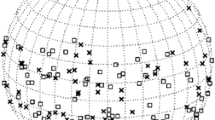Abstract
A statistical analysis of 135 out of 141 X-class flares observed during 1997 – 2012 with and without deca-hectometric (DH) type II radio bursts has been performed. It was found that 79 events (X-class flares and coronal mass ejections – Group I) were associated with DH type II radio bursts and 62 X-class flare events were not. Out of these 62 events without DH type IIs, 56 events (Group II) have location information, and they were selected for this study. Of these 56 events, only 32 were associated with CMEs. Most of the DH-associated X-class events (\({\sim}\,79~\%\)) were halo CMEs, in contrast to 14 % in Group II. The average CME speed of the X-class flares associated with DH type IIs is 1555 km s−1, which is nearly twice that of the X-class flare-associated CMEs without DH event (744 km s−1). The X-class flares associated with DH radio bursts have a mean flare intensity (\(3.63 \times 10^{-4}~\mbox{W}\,\mbox{m}^{-2}\)) that is 38 % greater than that of X-class flares without DH radio bursts (\(2.23 \times 10^{-4}~\mbox{W}\,\mbox{m}^{-2}\)). In addition to the greater intensity, it is also found that the the duration and rise time of flares associated with DH radio emission (DH flares) is more than twice than that of the flares without DH radio emission. When the events were further divided into two categories with respect to their source locations in eastern and western regions, 65 % of the events in the radio-loud category (with DH radio bursts) are from the western hemisphere and the remaining 35 % are from the eastern hemisphere. On the other hand, in the radio-quiet category (without DH radio bursts), nearly 60 % of the events are from the eastern hemisphere in contrast to those of the radio-loud category. It is found that 81 % of the events from eastern regions have flare durations > 30 min in the DH-flare category, in contrast to a nearly equal number from the western side for flare durations longer/shorter than 30 min. Similarly, the eastern events in the DH-flare category have a longer average rise-time of 34 min, while the western events have an average flare rise-time of 26 min. On the other hand, the CME speed and flare strength are found to be nearly equal among east and west side events, except that both these parameters are greater for events with DH type IIs.





Similar content being viewed by others
References
Acuña, M.H., Ogilvie, K.W., Baker, D.N., Curtis, S.A., Fairfield, D.H., Mish, W.H.: 1995, Space Sci. Rev. 71, 5. DOI .
Annalakshmi, M., Umapathy, S.: 2012, Astrophys. Space Sci. 338, 227. DOI .
Bougeret, J.-L., Kaiser, M.L., Kellogg, P.J., Manning, R., Goetz, K., Monson, S.J., Monge, N.: 1995, Space Sci. Rev. 71, 231. DOI .
Brueckner, G.E., Howard, R.A., Koomen, M.J., Korendyke, C.M., Michels, D.J., Moses, J.D., Socker, D.G., et al.: 1995, Solar Phys. 162, 357. DOI .
Gopalswamy, N., Lara, A., Kaiser, M.L., Bougeret, J.L.: 2001, J. Geophys. Res. 106, 25261. DOI .
Gopalswamy, N., Aguilar-Rodriguez, E., Yashiro, S., Nunes, S., Kaiser, M.L., Howard, R.A.: 2005, J. Geophys. Res. 110, A12S07. DOI .
Gopalswamy, N., Yashiro, S., Xie, H., Akiyama, S., Aguilar-Rodriguez, E., Kaiser, M.L., Howard, R.A., Bougeret, J.-L.: 2008a, Astrophys. J. 674, 560. DOI .
Gopalswamy, N., Yashiro, S., Akiyama, S., Mäkelä, P., Xie, H., Kaiser, M.L., Howard, R.A., Bougeret, J.-L.: 2008b, Ann. Geophys. 26, 3033. DOI .
Gopalswamy, N., Xie, H., Mäkelä, P., Akiyama, S., Yashiro, S., Kaiser, M., Howard, R., Bougeret, J.: 2010, Astrophys. J. 710, 1111. DOI .
Pappa Kalaivani, P., Umapathy, S., Shanmugaraju, A., Prakash, O.: 2010, Astrophys. Space Sci. 330, 237. DOI .
Pohjolainen, S., Allawi, H., Valtonen, E.: 2013, Astron. Astrophys. 558, A7, DOI .
Prakash, O., Umapathy, S., Shanmugaraju, A., Papa Kalaivani, P., Vršnak, B.: 2010, Solar Phys. 266, 135. DOI .
Prakash, O., Umapathy, S., Shanmugaraju, A., Vasanth, V.: 2012, Solar Phys. 281, 765. DOI .
Reiner, M.J., Kaiser, M.L., Gopalswamy, N., Aurass, H., Mann, G., Vourlidas, A., Maksimovic, M.: 2001, J. Geophys. Res. 106, 25279. DOI .
Reiner, M.J., Jackson, B.V., Webb, D.F., Mizuno, D.R., Kaiser, M.L., Bougeret, J.-L.: 2005, J. Geophys. Res. 110, A09S14. DOI .
Sharma, J., Mittal, N., Tomar, V., Narain, U.: 2008, Astrophys. Space Sci. 317, 261. DOI .
Suresh, K., Shanmugaraju, A.: 2014, Solar Phys. 290, 875. DOI .
Vasanth, V., Umapathy, S., Vršnak, B., Lakshmi, A.M.: 2011, Solar Phys. 273, 143. DOI .
Wang, Y., Zhang, J.: 2007, Astrophys. J. 665, 1428. DOI .
Yashiro, S., Gopalswamy, N., Michalek, G., St. Cyr, O.C., Plunkett, S.P., Rich, N.B., Howard, R.A.: 2004, J. Geophys. Res. 109, A07105. DOI .
Acknowledgements
The authors gratefully acknowledge the data provided by various online data centers of NOAA and NASA. We thank the Wind/WAVES team for providing the type II catalogs. The CME catalog is provided by the Center for Solar Physics and Space Weather, The Catholic University of America in cooperation with the Naval Research Laboratory and NASA. We also thank P.K. Manoharan, head of the Radio Astronomy Center, Ooty, for his support. A.S. acknowledges the major research grant No. 42 – 845/2013 (SR) from the University Grants Commission, Gov. of India. B.V acknowledges financial support by the Croatian Science Foundation under the project 6212-SOLSTEL “Solar and Stellar Variability”.
Author information
Authors and Affiliations
Corresponding author
Ethics declarations
Disclosure of Potential Conflicts of Interest
The authors declare that they have no conflicts of interest.
Rights and permissions
About this article
Cite this article
Lawrance, M.B., Shanmugaraju, A. & Vršnak, B. Investigation of X-class Flare-Associated Coronal Mass Ejections with and without DH Type II Radio Bursts. Sol Phys 290, 3365–3377 (2015). https://doi.org/10.1007/s11207-015-0811-z
Received:
Accepted:
Published:
Issue Date:
DOI: https://doi.org/10.1007/s11207-015-0811-z




